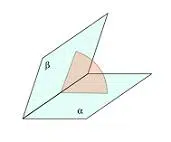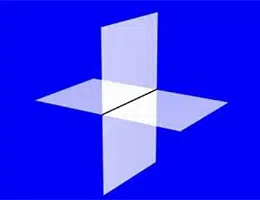 The Greek word dihedros came to Spanish as dihedral , a concept that is used in the field of geometry . The spatial portions that are limited by a pair of semiplanes originating from the same straight line are called dihedral angles .
The Greek word dihedros came to Spanish as dihedral , a concept that is used in the field of geometry . The spatial portions that are limited by a pair of semiplanes originating from the same straight line are called dihedral angles .
To represent a dihedral angle, it is necessary to use two parallelograms that have a common side . These figures allow us to symbolize the two semi-planes that, starting from the same edge, give rise to this type of angles.
Let us remember that the parallelogram is defined as a quadrilateral (a polygon that has four sides and four vertices) with the characteristic that its two pairs of opposite sides are equal and parallel. We understand by opposite sides, for clarification, those that do not have a vertex in common. The appearance of the parallelogram is very particular, since it looks like a square that has been deformed; In fact, the most common graphic editing programs have the option to alter images in this way to achieve different effects.
The other concept that appears related to the dihedral is the edge , which also belongs to the field of geometry. It is a line segment whose objective is to limit the side (or face ) of a plane figure. In the branch of geometry known as space geometry , which studies figures with volume that occupy space, we speak of an edge to refer to the segment in which two faces meet.
From an auxiliary plane that is perpendicular to the line of origin, the dihedral angle is obtained, whose value is equivalent to the amplitude reached by the smallest angle produced by the semilines that belong to the different half planes .
It can be said, in short, that a dihedral angle is a spatial region formed by two semiplanes with a common line. The faces of the angle are said semiplanes, while its edge is the aforementioned common line. The measure, for its part, is the smallest of its rectilinear angle.
According to their angles , it is possible to differentiate between a concave dihedral and a convex dihedral . Convex dihedrals, in turn, can be obtuse , straight or acute . On the other hand, depending on the characteristics of their rectilinear angles, we can speak of supplementary dihedrals and complementary dihedrals .
 Given the limitations of the tools available to students and teachers in school and college classrooms, the representation of dihedral angles on paper and on the blackboard is not usually done with the pertinent deformation that perspective would cause in the semiplanes, but rather which are drawn axonometrically .
Given the limitations of the tools available to students and teachers in school and college classrooms, the representation of dihedral angles on paper and on the blackboard is not usually done with the pertinent deformation that perspective would cause in the semiplanes, but rather which are drawn axonometrically .
The system for representing figures graphically known as axonometric perspective consists of using a cylindrical or parallel projection to draw volumes or geometric elements on a plane, in such a way that their proportions (height, length and width) are maintained at along each of the three axes on which it is projected.
In other words, in geometry books and in the sources we find on the Internet, the graphic representation of the concept of dihedral does not have a realistic perspective, that is, what an object would have in the real world. Thanks to this resource, it is possible to measure the sides of the half-planes and the extension of the edge regardless of the distance they are from the observer, since the result is always the same.
The notion of dihedral can also be found in other areas beyond geometry. A climbing center in the Chilean city of Iquique , a decoration house in Madrid ( Spain ) and a technology company in Zaragoza carry this term in their name.
